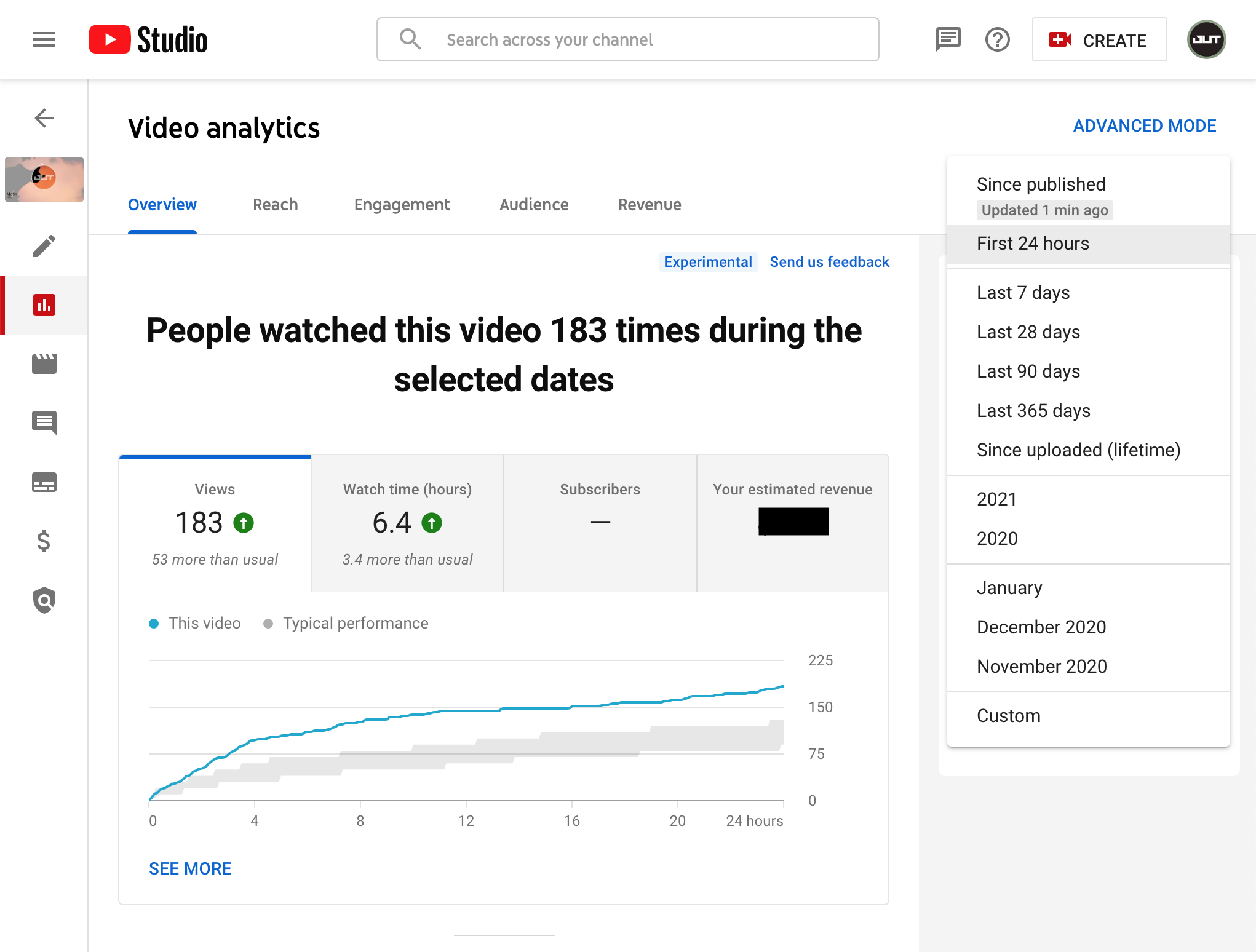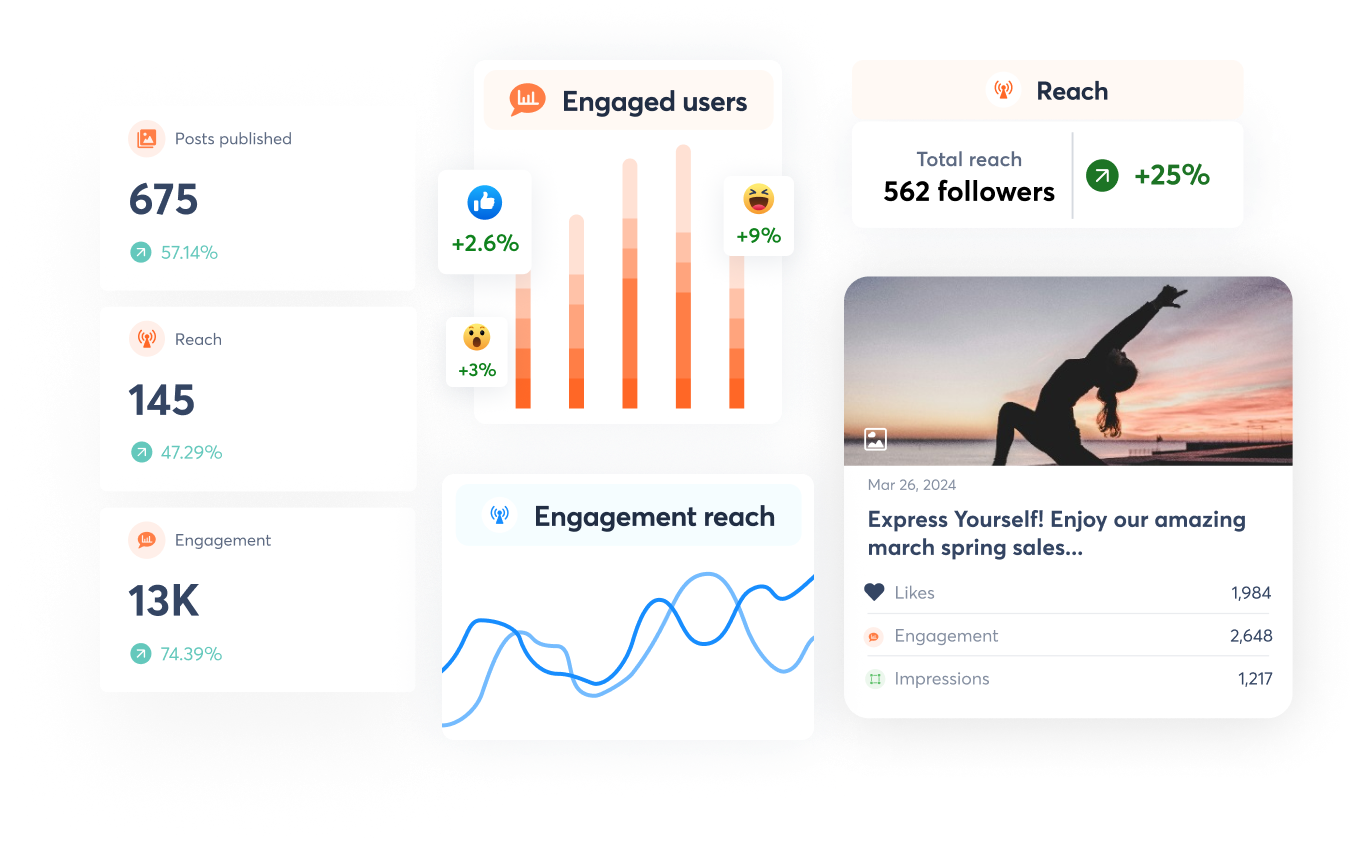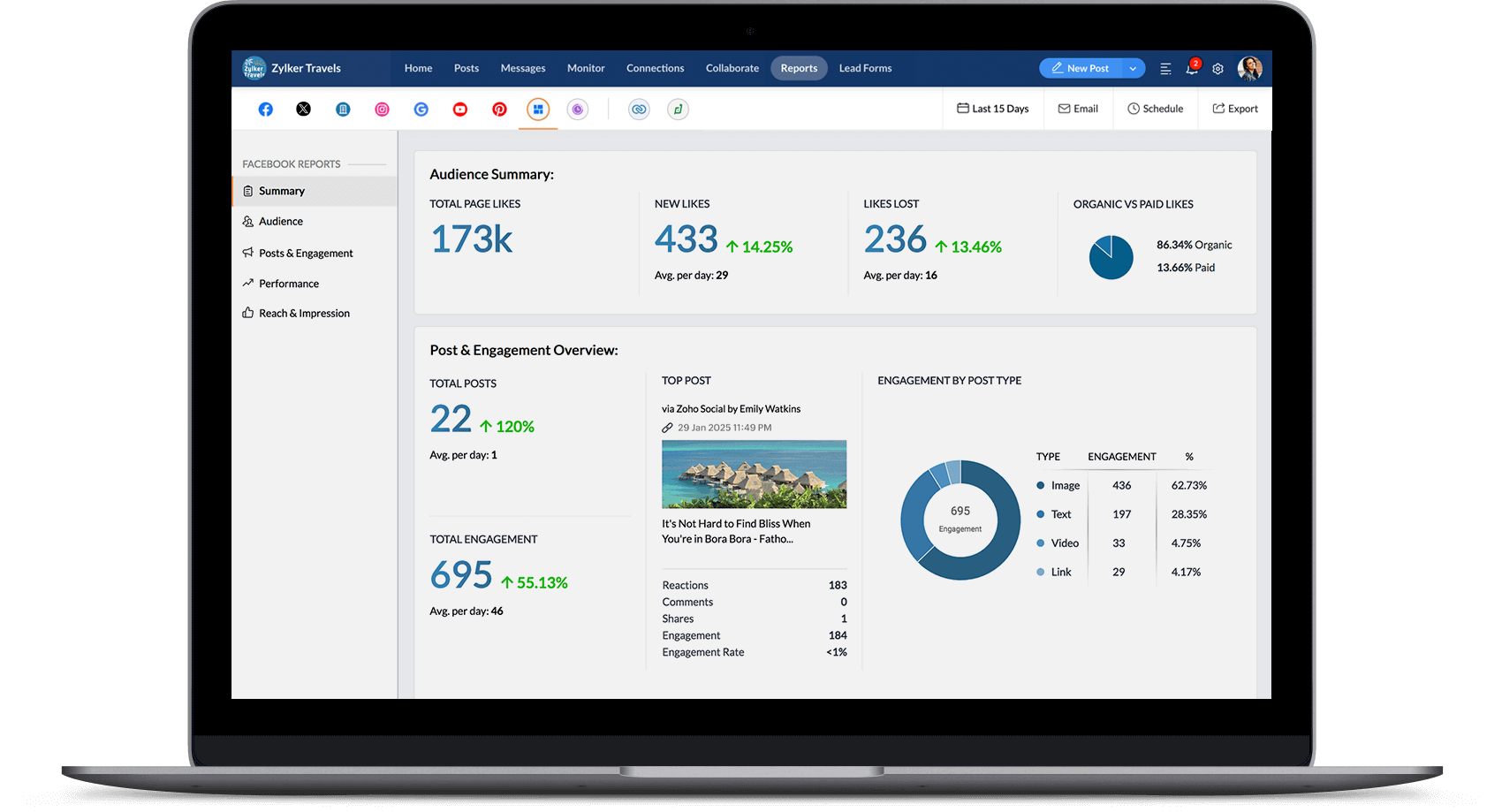What are the types of analytics available in these tools?
Social media analytics tools provide valuable insights into various aspects of your social media presence, helping you optimise your strategy and measure success. Understanding the different types of analytics is essential to gaining a clear view of your performance. Here are the main types of analytics available:
1. Audience analytics
Audience analytics focus on the people who engage with your content. These metrics give you insights into who your followers are. Key metrics to track include:
- Demographics: Age, gender, and location.
- Behaviour: Online activity, such as what times they are most active or which types of content they interact with.
- Growth: How your follower base is growing or declining over time.
2. Engagement analytics
Engagement analytics track how your audience interacts with your posts. These metrics provide insights into how well your content resonates with your audience and whether it’s sparking interaction. Common engagement metrics include:
- Likes, Comments, and Shares: The basic indicators of how people are interacting with your content.
- Click-through Rates (CTR): Measures how often people click on links, calls to action, or other interactive elements.
- Engagement Rate: The ratio of engagement actions (likes, comments, shares) to total followers, providing a more accurate measure of content effectiveness.
3. Content analytics
Content analytics focuses on how well individual pieces of content perform. This includes tracking the success of posts, images, videos, and campaigns. Key metrics might include:
- Impressions: The number of times your social media post is seen.
- Reach: The number of unique users who have seen your content.
- Content performance: How each piece of content performs, including engagement levels and CTR.
4. Posts sent/published
This metric tracks the number of posts you’ve sent or published across every social channel. It’s crucial for measuring your content output and understanding how frequently you are engaging your audience. Key things to track include:
- Frequency: How often you’re posting on each social media platform.
- Consistency: Whether you’re maintaining a consistent posting schedule.
- Timing: At what times posts are published to optimise engagement.
5. Mentions
Mentions refer to how often your brand, products, or content are mentioned across social media platforms. This can include direct mentions, tags, or discussions around your brand or specific campaigns. Key metrics to track include:
- Brand mentions: How frequently your brand name is mentioned, even without a direct tag.
- Sentiment of mentions: Whether mentions are positive, neutral, or negative, providing insight into how your audience perceives your brand.
- Influencers and reach: Identifying key influencers who are mentioning your brand on a social network and the broader reach of those mentions
How to analyse social media data?
Firstly, it's important to define what you want to achieve with a social media campaign or strategy. In social media marketing, measurable goals provide the context for interpreting data and social media performance can look different from brand to brand.
Some common objectives include:
- Brand awareness: Increasing visibility and getting your brand name in front of more people through a social media network..
- Lead generation: Using any social media channel to generate new leads or sales opportunities.
- Audience engagement: Building relationships with your followers through likes, comments, and shares.
- Community building: Developing a social media strategy that aids building a loyal community around your brand.
Once you’ve set clear goals, you can determine which social media metrics align with each objective, to help focus your social analytics and reveal actionable insight.
1. Identify key social media metrics to track
Based on your pre-determined goals, choose the metrics that will give you the most meaningful insights.
For example:
- For brand awareness, track reach and impressions.
- For audience engagement, monitor likes, comments, shares, and engagement rate.
- For lead generation, focus on click-through rates (CTR) and conversion metrics.
You may have different different key performance indicators (KPIs) for each social media network, so it’s important to understand what metrics matter most for your specific goals.
2. Use the right analytics tools for your brand
To gather and analyse social media data, you’ll need a got-to social media analytics tools, which also most likely a social media management tool. Many social media platforms offer their own built-in analytics (like, Instagram analytics, Twitter Analytics, etc.), but third-party tools like Sendible can provide a more comprehensive, detailed view.
A social media tool can help you:
- Aggregate data across multiple platforms in one dashboard.
- Provide visual reports for easier interpretation of results.
- Offer additional metrics not available natively on social platforms.
Choose the tool that best suits your needs, whether it’s for tracking organic performance, paid campaigns, or customer sentiment.
Top tip 💡
Social media analysis should be an ongoing process. Set up regular social media reporting (weekly, monthly, quarterly) to track progress toward your goals - which is easily done within a social media analytics tool. Regularly monitor your performance to ensure you’re staying on track and adjusting to new challenges or opportunities on any social media account. whill make keeping your team or stakeholders informed with up-to-date insights to make data-driven decisions faster.
How to track social media analytics for free
More often than not, as a social media manager, you're not given the biggest budget to work with, especially in a small business or solo entrepreneur. Tracking your social media analytics should never break the bank.
Alternative to third-party tools many social media platforms do offer free native social media analytics that provide valuable insights into your performance. While these free options may have some limitations compared to paid tools, they are still useful for getting started and understanding your social media presence.
Here’s how to track social media analytics for free:
1. Use Built-In Analytics on Social Media Platforms
Most major social media platforms provide free analytics for business or creator accounts. These tools allow you to monitor a range of performance metrics and gain insights into your audience and engagement without the need for a third-party tool. Some of the most popular social media platforms with built-in analytics include:
Instagram Insight: available for business and creator accounts, providing detailed data on your account’s performance. It contains:
- Post metrics
- Story analytics
- Audience insights
- Reels & video performance
Facebook Insights: available for Pages, offers comprehensive data to help businesses and creators evaluate their performance. Key features include:
- Post performance
- Audience demographics
- Page views and reach
- Engagement trends
TikTok analytics: available for Pro accounts, offers insights into video performance and audience behaviour. Its features include:
- Video metrics
- Follower insights
- Engagement rate
- Traffic sources

YouTube Analytics: offers robust metrics for creators and businesses to track video and channel performance. Key features include:
- Watch time & views
- Audience metrics
- Traffic sources
- Engagement stats
- Revenue insights

2. Google Analytics for Social Media Traffic
Another option is to use Google analytics as your social media analytics software. Although Google Analytics is traditionally used for website tracking, it can also be a great tool for monitoring the effectiveness of your social media efforts and to understand how each social platform is performing. You can use this by setting up UTM parameters, to track the traffic that comes to your website from social media platforms.
- Track Traffic Sources: By adding UTM parameters to your social media posts or links, Google Analytics can identify the source of traffic (e.g., Facebook, Twitter, Instagram). You can see how much traffic each social media platform is sending to your site and how that traffic behaves once it arrives.
- Conversion Tracking: You can also track conversions (e.g., sign-ups, purchases, or downloads) that originate from social media. This helps measure the ROI of your social media campaigns.
Extra: Did you know Sendible is integrated with Google analytics for even more analytical insight?
The 5 Best social media analytics tools
Choosing the right social media analytics tool can make all the difference in optimising your overall marketing strategy. Tools provide actionable insights into your social media performance, helping you track growth, and engagement. Below, we highlight 5 top tools, detailing their unique features, pricing, and suitability for different users. We’ve also included a quick advantages and disadvantages breakdown for each tool to help you decide.
1. Sendible
Starting off with a personal favourite - Sendible is a social media management tool with advanced analytics features tailored for agencies, franchises, and brands handling multiple clients or accounts.
Sendible offers in-depth cross-social media reporting, enabling users to track performance metrics across various platforms in one centralised dashboard. Also, Sendible has the capability to report on individual marketing campaigns with detailed analytics to measure campaign success through key metrics like engagement and reach.
For agencies and franchises, Sendible’s white-label options are a game-changer. This feature lets users brand reports and dashboards with their own logos and colour schemes, ensuring consistency and professionalism in client communications
Unique Features:
- Customisable analytics reports with a plethora of modules to choose from.
- Social media Campaign reporting.
- Automated report creation and dissemination.
- White-label reports for branding purposes.
Advantages:
- Highly customisable quick reports.
- Powerful integration options with analytics tools like Google Analytics.

2. Sprout Social
Sprout Social offers a unified platform for social media management and analytics. Its analytics features include audience insights, post performance tracking, and social listening tools. Sprout Social also provides both pre-designed templates and customisable reporting options, offering flexibility in collecting key social metrics and presenting them to others in a clear and impactful manner.
Unique Features:
- Cross-platform analytics and trend reporting.
- CRM features to track audience interactions.
- Social listening options for tracking brand mentions and sentiment.
Advantages:
- Excellent for brands that need integrated CRM and analytics.
- Social listening capabilities.
Disadvantages:
- Pricing may be higher for smaller businesses.
3. Buffer
Buffer is an accessible and cost-effective tool for social media scheduling and analytics, tailored to meet the needs of small teams and individual users. You can incorporate metrics and charts from multiple channels into your reports, ensuring a clear and organised overview. Once set up, reports update automatically each day, allowing you to stay informed with minimal effort.
Unique Features:
- Simple, clean interface for tracking engagement.
- Analytics reports on posts, stories, and campaigns.
- Affordability and ease of use.
Advantages:
- Budget-friendly for individuals and small teams.
- Streamlined interface ideal for beginners.
Disadvantages:
- Limited advanced analytics features like social listening compared to other tools.
4. Agorapulse
Agorapulse is a flexible social media management tool ideal for brands focused on streamlined engagement and performance tracking. It helps you identify top-performing content on each platform, measure performance through reach, clicks, and engagement rates, and monitor team response times to ensure quick handling of brand interactions
Unique Features:
- In-depth analytics for posts, engagement, and audience growth.
- Team collaboration and tracking features.
Advantages:
- Easy-to-use interface with powerful analytics.
- Strong engagement tracking tools.
Disadvantages:
- Pricing can be steep for startups or small teams.
5. Zoho Social
Zoho Social is a flexible tool designed for businesses and marketers to manage their social media presence while tracking analytics. It provides insights into engagement, audience growth, and campaign performance across key platforms. You can learn more about your audience, including their location, language, and demographic details.
Unique Features:
- Real-time monitoring of mentions and audience engagement.
- Analytics reports for post performance, reach, and impressions.
- Integration with other Zoho tools like Zoho CRM for enhanced marketing workflows.
Advantages:
- Affordable and accessible for small businesses and startups.
- Seamless integration with the Zoho ecosystem for a unified experience.
- Real-time monitoring for immediate insights.
Disadvantages:
- Advanced features, like custom reports, are available only in higher-tier plans.
Wrapping it up
You've made it to the end! By now you probably understand social media analytics tools are essential for understanding how your content performs, identifying trends, and refining your strategy to meet your goals.
Whether you’re a small business owner, a marketer, or part of a large agency, the right analytics tool can transform raw data into actionable insights, saving you time and maximising your ROI.
The key to success lies in choosing a tool that aligns with your business objectives, fits your budget, and offers the features you need to optimise your social media efforts. As social media continues to evolve, staying on top of your analytics will ensure you remain competitive, informed, and ready to capitalise on every opportunity.
Text copied!














